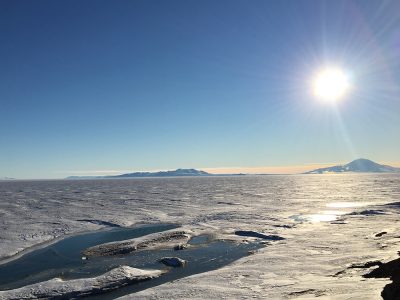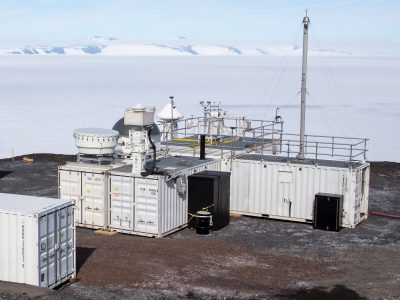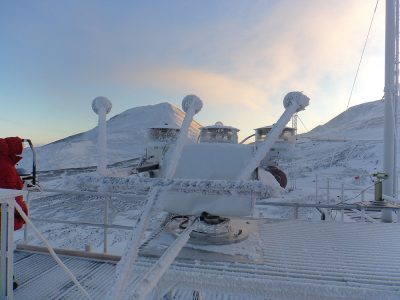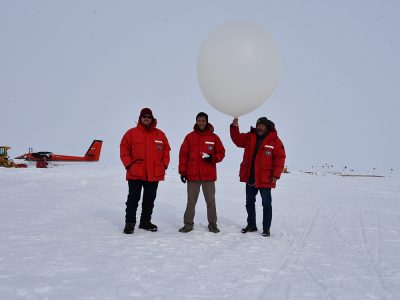ARM Successfully Completes Challenging Antarctic Atmospheric Study
Published: 20 February 2017
First sophisticated Antarctic cloud, aerosol data collected to improve earth system models for the region

In a science campaign of unprecedented challenge, researchers recently completed the first substantial climate measurements on the West Antarctic Ice Sheet in 50 years. Sophisticated instruments collected data that may help explain changes in this remote continent, which could have global implications.
Antarctica contains the largest of the world’s three great ice sheets, which contain most of the planet’s freshwater, and accounts for 90 percent of the planet’s ice, a global heat sink. West Antarctica’s ice sheet—more than 34 million years old—is one of the most rapidly warming regions on Earth, capable of raising sea levels by 11 feet or more, and its changing climate is linked to loss of ice across the continent and global sea level rise. More data from multiple sources are needed to improve earth system models to predict how climate will continue to change in this region.
While Arctic data are more plentiful, Antarctica has remained a major source of uncertainty about sea-level rise greatly because Antarctica is an extremely remote, challenging environment. The mechanisms behind West Antarctic warming remain a mystery, but scientists hypothesize a linkage between moisture from Southern Ocean storm clouds and the surface energy balance over this ice sheet may play a role.
Unprecedented Antarctica Research

In a historic campaign, the U.S. Department of Energy’s Atmospheric Radiation Measurement (ARM) Climate Research Facility and the National Science Foundation (NSF) partnered to deploy ARM’s unique, advanced cloud and aerosol instruments to Antarctica in November of 2015 to probe the clouds and climate. The campaign, called the ARM West Antarctic Radiation Experiment (AWARE), was motivated by a need to collect a sophisticated, complete atmospheric data set to elucidate West Antarctica’s rapid warming.
“Ice mass loss from West Antarctica is now the second largest cryospheric contribution to global sea level rise, after Greenland, and this contribution is expected to increase,” said Dan Lubin, AWARE’s lead scientist and a researcher at Scripps Institution of Oceanography. “Right now we don’t have a comprehensive explanation for the atmospheric warming over West Antarctica, and we need thorough meteorological and radiometric measurements to test competing hypotheses.”
ARM deployed a mobile facility to McMurdo Station at the tip of West Antarctica for 14 months, plus a suite of instruments to the West Antarctic Ice Sheet (WAIS) Divide Ice Camp plateau, where storms travel inland, during Antarctica’s summer season.

For the first time ever, research cloud radars and advanced radiometric instrumentation (backed up with a full suite of meteorological observations) were deployed to Antarctica.
The sophisticated suite of instruments deployed at McMurdo Station included cloud radars (scanning and zenith), high-spectral-resolution lidar, broadband and spectral radiometers, a complete aerosol suite, plus instruments to measure surface energy balances and water columns. At WAIS, the instruments included a ceilometer for cloud base height, radiometers for the surface energy budget and water vapor profiles, and surface meteorological instruments. Data-collecting instruments suspended below weather balloons, known as radiosondes, were also launched four times per day at WAIS.
Data were collected and are now being analyzed to illuminate the atmospheric energy balance, cloud microphysics, precipitation and aerosol cycles and chemistry.
Interdisciplinary, Multi-lab Team
The AWARE science team is a collaboration of researchers from Scripps Institution of Oceanography, Pennsylvania State University, Ohio State University, and Brookhaven National Laboratory, who are eagerly exploring the unprecedented data collected during AWARE. The cross-disciplinary science team greatly strengthens AWARE’s uniqueness and success; whether their focus is scrutinizing the surface energy balance from multiple locations, analyzing aerosol data, or providing meteorological insight at multiple scales via climate modeling and satellite remote sensing—each disparate effort exponentially strengthens the ultimate goal: interpreting new Antarctic data and creating more accurate, more complete earth system models and predications.
In addition to research, Ohio State also provided weather and climate support for the mission, providing current model predictions, satellite and surface observations, and climate analysis for West Antarctica.
One of the most challenging ARM field campaigns ever conceived, AWARE’s success depended upon field deployment experts at Los Alamos National Laboratory who managed the mobile facility, their contractors, and the NSF’s Antarctic Support Contract.
Revealing the Cloud, Global Climate Connection
Clouds (and aerosols they contain) reflect or absorb heat depending on their composition. Cloud information was scarce for the southern high altitudes until AWARE. In fact, the largest source of uncertainty in today’s climate models are clouds and how changes in clouds may feedback to the Earth system. Climate modelers need data to evaluate and improve their representation of cloud physics and the feedbacks between clouds, weather systems, and the energy balance in order to ultimately improve projections of sea-level rise. Scientists, using ARM data and observations, will analyze the particles’ shape, size, and chemical composition to determine how they absorb or scatter light (radiation) and therefore warm or cool Earth and the atmosphere.
Using satellite data, multiple recent studies revealed that large West Antarctic glacier systems are collapsing due to warming. These rapid changes contrast with more modest losses recorded by glaciological fieldwork in the 1970s—the last substantial climatological field work on that side of the Antarctic continent. Recently observed rapid loss of sea ice around Antarctica that makes continental ice vulnerable to collapse has been blamed on a meteorological cycle known as the Southern Annular Mode—movement patterns of prevailing winds from the west that carry warmth inland from the ocean. AWARE-related research challenges this idea and researchers now see strong influence of Southern Ocean low pressure cells in driving warm air and moisture over West Antarctica.
AWARE radar data already illustrate the prevalence of mixed-phase clouds with large ice water content and their role in the surface energy balance. Large vertical velocities in clouds—three times larger than found in the Arctic—caused by mountainous terrain were detected. While detailed analysis continues, these new data support improvement of mixed-phase cloud parameterizations in cloud models.
Extreme Environment Challenges Instruments, Staff

135 degrees below zero Fahrenheit. That’s how cold Antarctica can get. Survival is a challenge, and so is trying to keep highly sensitive climate research equipment—situated outside where it is exposed to the cold and hurricane-force winds—operable. Repairing or modifying such equipment with bulky gloves protecting fingers that can freeze with one second of exposure to the elements is problematic, to say the least.
Logistics were further complicated by the expense and difficulty of transporting staff, scientists and equipment to the remote continent. All equipment had to be delivered to the WAIS divide on one flight. Equipment and instruments were painstakingly customized to withstand the extreme conditions. Replacing a broken or malfunctioning piece was impossible.
About a dozen remote field-operations management and engineering experts flew to Antarctica from all over the world and spent months on the ice to help support AWARE and the visiting scientists.
Enduring months of complete darkness during winter and summer months of midnight sun, two full-time operators stayed onsite at the McMurdo and WAIS divide sites to maintain the mobile facility and instruments. Data were collected 24 hours a day, and, surprisingly, the harsh environment did not cause serious data losses.
“We were very fortunate that the forty days of data collected from WAIS Divide Ice Camp represent a wide variety in summertime meteorological conditions that will allow researchers to directly test competing hypothesis about West Antarctic warming,” Lubin said.
AWARE Data Available
Operators painstakingly disassembled the ARM Mobile Facility and transported it off Antarctica in January of this year. Infrastructure and instruments are in transit to various continents for extensive modification before ARM’s next mobile deployment aboard an ice breaker in the Southern Ocean.
AWARE collected 30 percent more data than a typical mobile facility deployment—that is 35.44 terabytes of baseline operations, 6.1 gigabytes of field campaign data, and 28 gigabytes of evaluation data. AWARE data are available to researchers worldwide free-of-charge to help elucidate polar atmospheric processes from the ARM Data Center.
While premature to state AWARE’s science impact, researchers report the novel data have already supported new models and conclusions, with papers submitted to peer-reviewed journals.
“The science team’s multi-disciplined efforts will only scratch the surface with this new data set,” Lubin said. “Much of what we’re doing right now is in the form of community service: preliminary analysis to help other researchers better understand the data to evaluate climate change models and test hypotheses.”
Lubin concluded that the data set was outstanding. AWARE provided an atmospheric data set of unprecedented quality and completeness for Antarctica that may help explain the rapid warming and, ultimately, reduce uncertainty in global and regional climate model simulations and projections.
# # #
The ARM Climate Research Facility is a national scientific user facility funded through the U.S. Department of Energy’s Office of Science. The ARM Facility is operated by nine Department of Energy national laboratories, including Los Alamos National Laboratory, which managed the AWARE deployment.
The ARM Climate Research Facility is a DOE Office of Science user facility. The ARM Facility is operated by nine DOE national laboratories, including .
Keep up with the Atmospheric Observer
Updates on ARM news, events, and opportunities delivered to your inbox
ARM User Profile
ARM welcomes users from all institutions and nations. A free ARM user account is needed to access ARM data.


















